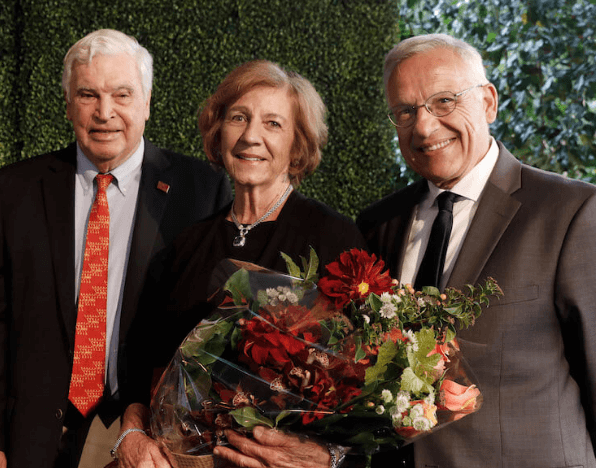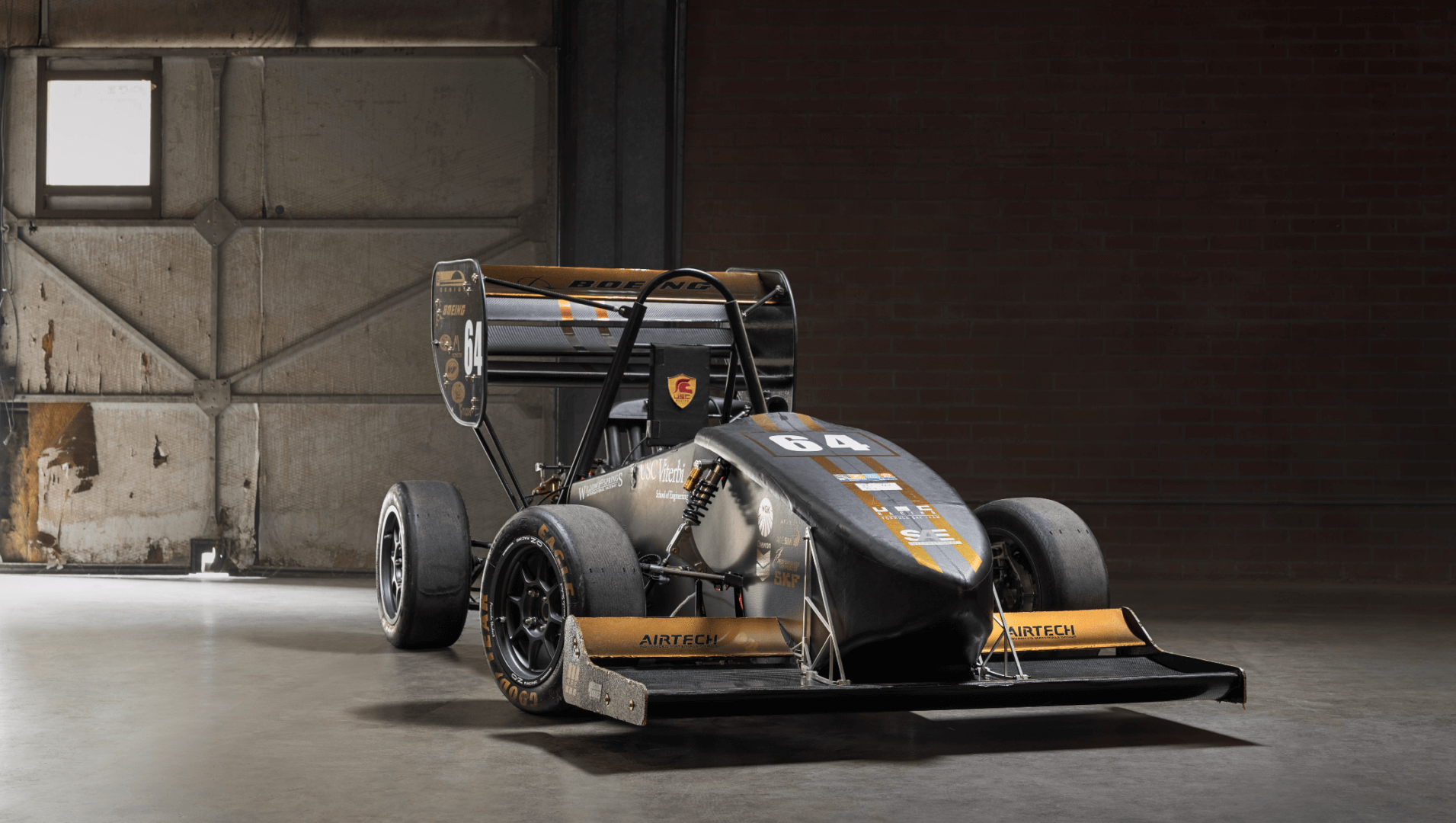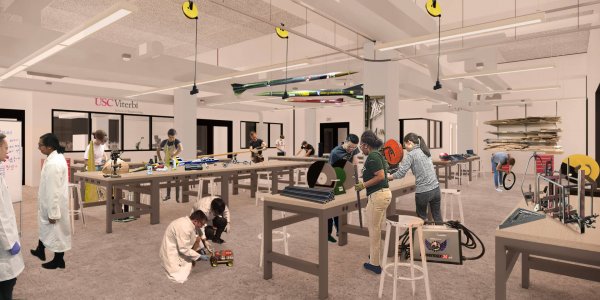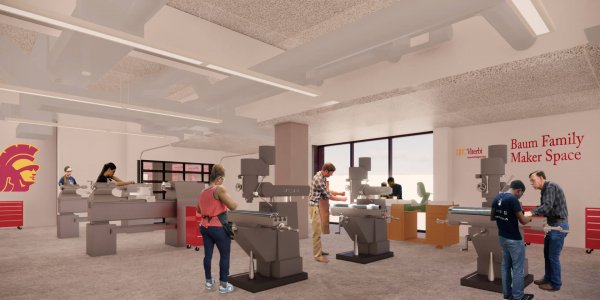A Real Page-Turner
On a recent afternoon, when traffic inevitably jammed on Interstate 5 in San Diego County, a USC professor pulled off the freeway to kill time at a favorite spot: the Del Mar Branch Library.
The cozy library is housed in a Craftsman-style former church built in 1914. There’s a free magazine swap section and used paperbacks that sell for 25 cents.
While enjoying the sea view, Yolanda Gil, research professor of computer science and of spatial sciences at USC Viterbi, dove into some work. Oddly enough, her work concerned libraries, but not old-school libraries like the Del Mar Branch. She’s focused on the libraries of the future.
At USC, libraries are in the thick of change. A “maker space” is being installed in the university’s Science and Engineering Library. Scholars are looking at ways to use AI to improve digital access to research materials. The dean of libraries has big dreams for a state-of-the-art robotic system to access materials. And there’s talk of creating a hologram librarian that could appear in dorm rooms.
“Libraries are transforming, and what librarians do is evolving, and that’s always been the case,” said Catherine Quinlan, who as dean of USC Libraries runs the university’s 23 libraries.
“A maker space, such as the planned Baum Family Maker Space, is particular to our time and place,” Quinlan said. “Their characteristics may be specific to the community it supports, but they are essentially one current embodiment of what libraries always have been: places of discovery, creativity and invention.”
Books and magazines haven’t disappeared — and won’t. Many are being digitized, but digitization should not preclude preservation, librarians and scholars point out. For a number of reasons (including preserving documents and scripts made hundreds of years ago), libraries preserve physical items as well. The larger world of information, contained in books, magazines, music and more, lives in many forms, each of which has a purpose.
New Tools for New Mindsets
At USC, work has begun on what is affectionately being called the “Baum Shelter,” a remodeling of the first floor of the Science and Engineering Library into a maker space, a multipurpose area for student exploration and creative making. This is a first and concrete example of how USC Libraries are responding to new mindsets for learning and discovery.
Supported by the Baum Family, the Baum Family Maker Space is set to open in spring 2020 (see below).
Yannis C. Yortsos, dean of USC Viterbi, which is spearheading the project, said the concept comes as engineering schools look for new ways for students to innovate and thrive in their engineering education.
Libraries are dramatically evolving from the one Yortsos frequented while growing up on the island of Rhodes in Greece. He recalls a dark, damp place focusing on archaeological resources that he compared to the Cemetery of Forgotten Books in Spanish writer Carlos Ruiz Zafón’s best-selling novel, “Shadow of the Wind.”
“I think that libraries will transform into spaces that help learning of all kinds, from experiential, such as in maker spaces, to the incubation of new innovative ideas, to spaces for reflection and to places where people can get together and brainstorm ideas,” Yortsos said. “Most likely they’ll become a combination of all of that for the benefit of our students and the public alike. Such spaces will cultivate in our students a stronger sense of collaboration, discovery, leadership and innovation. ”
As the lead of the initiative on the Scientific Paper of the Future, Gil and other leading computer scientists and engineers are developing uniform tools for researchers to use so their papers and all supporting material — data, software, workflows, etc. — can easily be stored and accessed digitally. This brings up interesting and intriguing questions. For example, how might university libraries use artificial intelligence to better document, store, archive and preserve scholarly research not only after it’s been conducted, but while it’s being done?
The point of the initiative is to make scientific research more open, to promote fair credit of scientific contributions, and to make it easier for future researchers to reproduce, refine and remix past research.
“Which brings me to libraries,” explained Gil, director of knowledge technologies and associate division director at the USC Information Sciences Institute. “Data, software and all other digital objects that we create have to be published and disseminated, and that’s what libraries understand: the archival process and preservation of all the data and software we use, not just books and papers.”
Libraries — university and public, and around the world — are transforming physically as well as digitally. For example, the University of Chicago recently created the Automated Storage Retrieval System (ASRS), a robotic system that allows librarians to store, in an archivally perfect climate, paper materials, primary research materials and archives that can easily be retrieved.
Hanna Reisler, the Lloyd Armstrong Jr. chair in Science and Engineering and professor of Chemistry at USC, recognizes the need for libraries to become more enticing for young people and college students. She noted that for some time, libraries have put up periodic displays of books on specific topics complemented by lectures and discussions. Also, college libraries have brought specific displays of books to student dormitories — again, complemented by discussions. Students who see specific books can then order them either in printed or electronic form.
Reisler, who like Gil would feel at home in a cozy nook at the Del Mar Branch Library, urges that such uses of libraries be ramped up even more. But she recognizes the need for libraries to maintain their physical collections.
“There’s no substitute for leafing through the pages of a book to get a sense to it,” Reisler said, “and many old books, especially in fields such as math and philosophy, should still be seen by students and researchers in their original form.
“With the disappearance of traditional bookstores, libraries are almost the only places where young people can see printed books. Therefore, libraries should assume, to some extent, the role of bookstores as a place where young people browse,” she added.
Gisele “Gigi” Ragusa, USC Viterbi Professor in the Division of Engineering Education, chairperson of the USC STEM Consortium and co-chair of the Provost-Academic Senate Library Committee, sees a natural and important creative tension in libraries needing to maintain both physical and virtual resources.
Ragusa notes that learning occurs virtually, formally, experientially and informally in libraries — hence the need to maintain both physical and digital spaces.
“Whether you’re sitting in one of the rooms and working, studying, conducting research, working on a project, working in a maker space or working virtually by using the huge amount of electronic resources we have, you’re learning,” she said.
A Hologram Librarian?
Libraries, of course, have been around since ancient times. The Great Library of Alexandria in Egypt, built around 250 BC, was one of the largest and most significant. In fact, it is considered the first form of a university.
Indeed, it and others like the early Carnegie libraries built in the 1800s always were about much more than books. Libraries served as community gathering spots and even think tanks, writes Shannon Mattern in the June 2014 issue of Places Journal.
Quinlan sees value in putting a maker space inside the Science and Engineering Library.
“There will be easy access to information and information expertise in the same space in which students are creating and discovering,” Quinlan said.
She rejects the notion that libraries are undergoing a sort of existential crisis as they adapt to rapidly evolving technology and changes in the way people consume information.
“We’re not figuring out what we want to be,” said Quinlan, who’s been in library management for 30 years. “Every time the medium changes, how we do our job changes, but not what we do. Fundamentally, our aim is to help you be successful and learn to find and use credible information.
“We know what we’ve been, we know what we are, and we know what we want to be,” she added.
An Aug. 24, 2016, Business Insider article on libraries of the future, quoting experts at the Institute for the Future in Palo Alto, projects that within 50 years, libraries will become “all-in-one spaces for learning, consuming, sharing, creating and experiencing.” The story projects that future library visitors could download sensory data and experience what it feels like, for example, to visit another planet or inhabit the mind of the family dog.
Much closer at hand, said Quinlan, are ways for USC’s libraries to become more interwoven into the fabric of the university.
A few years ago, Quinlan sponsored a project suggested by one of the library faculty to work with researchers at the USC Institute for Creative Technologies to develop a prototype of a PHIC hologram librarian.
“My dream,” Quinlan said, “is to have a hologram librarian at various places across campus that you can go and ask various questions. There is a predictable set of questions that any new user of a library asks. To automate that interaction in a meaningful and personal way would free up our librarians to engage even more deeply with research and teaching.”
Added Quinlan: “Why can’t I take all the smarts that I have in my library faculty and translate that in a digital form that can go anywhere and be anywhere? If we could have a hologram librarian helping you in your dorm room, think of all the other ways we could apply all the expertise of library faculty in person and throughout the digital realm.”
The concept of a holographic librarian is not too far away, predicted Quinlan, dean of USC libraries since 2007. She recently won an Emmy as executive producer for a segment on “Lost L.A.,” a USC Libraries collaboration with public media company KCETLink about Los Angeles history told through the collections of Southern California libraries and archives.
Gil envisions a time in the not too distant future when librarians will become the data and software cataloguers for the university. From the library point of view, this is akin to a kind of special collection — digital knowledge objects that have their own set of discovery and preservation requirements, just as rare books, manuscripts and other special materials do.
Researching food shortages in South Saharan Africa, for example? Flip open your laptop, Gil said, and you’ll be able to easily find information about the region’s climate, agriculture, population, subsidies, government policies, etc., as well as the scholars researching the topic.
“Right now, everybody keeps their information on their own private drives and no one else knows that it exists,” said Gil. “Libraries will help us catalogue all the data available within the university and beyond.
Thinking Big
USC’s primary source Special Collections include archives, manuscripts, historic photographs and rare books in the main areas of Holocaust and Genocide Studies, Iberian and Latin American Studies, Lewis Carroll and Alice in Wonderland, Lion Feuchtwanger and the European exiles of the 20th century in Southern California, natural history, Southern California regional history, and USC history.
Quinlan envisions improved virtual reality technology that would allow people to put on a headset and soak up these and other valuable university assets. As she did with the recently renovated Thomas and Dorothy Leavey Library, Quinlan is in the process of “reimagining” the Norris Medical Library with her colleagues in the Keck School of Medicine of USC.
One of her dreams is to build at USC an ASRS like the one the University of Chicago has. The project, still in the planning stage, would cost $40 million, Quinlan said.
“I keep thinking all these successful entrepreneurs who have an engineering background who want to demonstrate what they’re doing with technology could really help preserve information that has great cultural significance,” Quinlan said.
“And they could name it after themselves,” she said, smiling, “and there’ll be four robots they could name after their kids.”
Ragusa, who grew up in L.A. and fondly recalls countless visits to the majestic main Los Angeles Public Library downtown, sees libraries as collaborative spaces with spaces for innovation, physical access to archival historical information, and limitless virtual spaces “where we can connect across the globe. Libraries are becoming learning labs that have a lot of tentacles, and that’s what’s really exciting.”
Welcome to the ‘Baum Shelter’
Formally, it’s the Baum Family Maker Space. But affectionately, it’s called the Baum Shelter.

Currently under construction in the Science and Engineering Library, it’s named after the man whose generous gift made it possible: Dwight J. “Jim” Baum, chairperson of the USC Viterbi School of Engineering’s Board of Councilors. The Baum Shelter is set to open in spring 2020.
The maker space will feature a machine shop, a wet lab, a 3-D shop, a paint booth and a design space. It also will be outfitted with 3-D printers, laser cutters and reconfigurable workbenches, and will include a unified space for USC Viterbi’s student design and competition teams.
“When it was first suggested to us that the planned maker space be located in the repurposed lower floor of the Engineering Library, I was a little skeptical,” Baum said. “New construction would actually be less expensive and faster than a remodel. But thinking more, it was an ingenious solution.”
Baum said the central location was ideal for busy students, and the historic building was constructed so its floor loads could handle heavy library stacks — ideal for the machines that will be installed in the maker space.
“Even more important,” Baum said, “it will provide easy access to a most important tool for our makers: the rich body of knowledge that comes from past and current creators that only an up-to-date digital library and its staff could provide.”
Immediately upstairs from the Baum Family Maker Space, students will find the essential context for their discovery and creations through thousands of digital research resources and the expertise of dedicated science and engineering librarians.
“The enthusiasm of the librarians cemented the idea,” Baum said of his gift. “We will create a space where information will come together with the tools and minds that will build the future of engineering and society. As we like to say at Viterbi, it’s engineering reimagined.”






